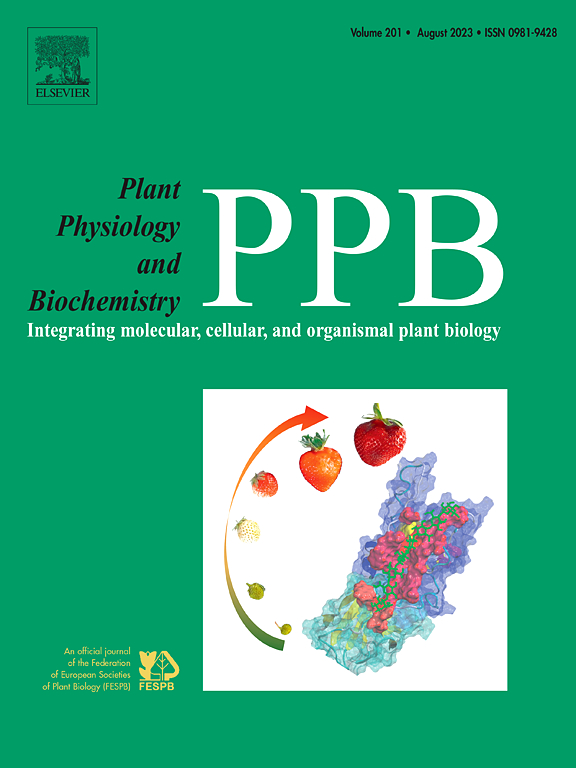Endophytic Enterobacter ludwigii S15 mitigates cadmium accumulation and promotes tobacco growth via polyamine biosynthesis and metal transporter regulation
IF 5.7
2区 生物学
Q1 PLANT SCIENCES
引用次数: 0
Abstract
Reducing cadmium (Cd) uptake in tobacco is critical for crop safety and human health. While heavy metal (HM)-immobilizing bacteria have been widely studied, the specific mechanisms by which exogenous endophytic bacteria regulate tobacco growth and Cd homeostasis remain unclear. Here, we isolated Enterobacter ludwigii S15 from maize roots in Cd-contaminated soil and identified its strong Cd-immobilizing capacity and plant growth-promoting traits. In pot experiments with 3 and 5 mg kg−1 Cd, S15 colonization significantly enhanced tobacco growth by reducing Cd uptake and root-to-shoot translocation, modifying subcellular Cd compartmentalization, and increasing photosynthetic pigment content. Moreover, S15 downregulated the expression of key Cd transporter genes (NtZIP1, NtZIP2, NtZIP4, NtNRAMP3), enhanced Cd tolerance by modulating antioxidant enzyme activities, promoted soluble sugar accumulation, and upregulated polyamine biosynthesis genes (ADC, SAMDC, SPD synt). Collectively, these findings elucidate the mechanistic basis by which E. ludwigii S15 alleviates Cd stress and promotes plant growth, highlighting its potential as an effective biotechnological agent for mitigating Cd accumulation in tobacco cultivated on contaminated soils.

内生路德维希肠杆菌S15通过多胺生物合成和金属转运体调控减轻镉积累,促进烟草生长
减少烟草对镉的吸收对作物安全和人类健康至关重要。虽然重金属固定化细菌已被广泛研究,但外源内生细菌调节烟草生长和镉稳态的具体机制尚不清楚。本研究从cd污染土壤中的玉米根中分离出路德维希肠杆菌S15,并鉴定出其具有较强的cd固定化能力和促进植株生长的性状。在3和5 mg kg−1 Cd盆栽试验中,S15定殖通过减少Cd吸收和根尖转运、改变亚细胞Cd区隔和增加光合色素含量显著促进烟草生长。此外,S15下调Cd关键转运基因NtZIP1、NtZIP2、NtZIP4、NtNRAMP3的表达,通过调节抗氧化酶活性增强Cd耐受性,促进可溶性糖积累,上调多胺生物合成基因ADC、SAMDC、SPD synt。综上所述,这些发现阐明了E. ludwigii S15缓解镉胁迫和促进植物生长的机制基础,突出了其作为一种有效的生物技术剂减轻镉在污染土壤上种植的烟草中的积累的潜力。
本文章由计算机程序翻译,如有差异,请以英文原文为准。
求助全文
约1分钟内获得全文
求助全文
来源期刊
CiteScore
11.10
自引率
3.10%
发文量
410
审稿时长
33 days
期刊介绍:
Plant Physiology and Biochemistry publishes original theoretical, experimental and technical contributions in the various fields of plant physiology (biochemistry, physiology, structure, genetics, plant-microbe interactions, etc.) at diverse levels of integration (molecular, subcellular, cellular, organ, whole plant, environmental). Opinions expressed in the journal are the sole responsibility of the authors and publication does not imply the editors'' agreement.
Manuscripts describing molecular-genetic and/or gene expression data that are not integrated with biochemical analysis and/or actual measurements of plant physiological processes are not suitable for PPB. Also "Omics" studies (transcriptomics, proteomics, metabolomics, etc.) reporting descriptive analysis without an element of functional validation assays, will not be considered. Similarly, applied agronomic or phytochemical studies that generate no new, fundamental insights in plant physiological and/or biochemical processes are not suitable for publication in PPB.
Plant Physiology and Biochemistry publishes several types of articles: Reviews, Papers and Short Papers. Articles for Reviews are either invited by the editor or proposed by the authors for the editor''s prior agreement. Reviews should not exceed 40 typewritten pages and Short Papers no more than approximately 8 typewritten pages. The fundamental character of Plant Physiology and Biochemistry remains that of a journal for original results.

 求助内容:
求助内容: 应助结果提醒方式:
应助结果提醒方式:


